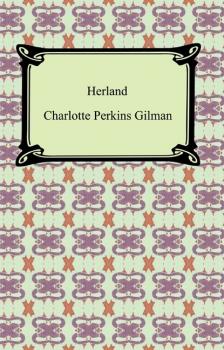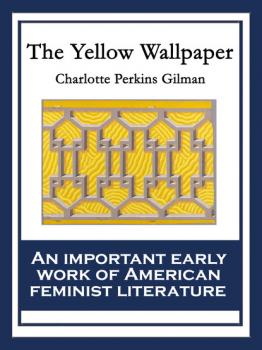ТОП просматриваемых книг сайта:
Charlotte Perkins Gilman
Список книг автора Charlotte Perkins GilmanАннотация
Charlotte Perkins Gilman (1860-1935) was an American sociologist, author, poet, and lecturer whose influential work and unorthodox lifestyle made her an icon for future generations of feminists. Much of her work criticized common perceptions of the role of women in marriage and society, and advocated educational, financial, and cultural equality for women. This edition features «Herland», a utopian novel about the exploration of an isolated, entirely female, society by three American men. Also included is her most famous work, «The Yellow Wall-Paper», a semi-autobiographical story written by Gilman in 1890 after a severe bout of post-partum depression. The story of a woman who is driven insane after three months trapped in her home, deprived of any mental stimulation, was a direct criticism of the doctor who «treated» Gilman's depression. The stories and poems in this collection were taken from newspapers, periodicals and Gilman's self-published magazine, «The Forerunner».
Аннотация
Charlotte Perkins Gilman (1860-1935) was an American sociologist, author, poet, and lecturer whose influential work and unorthodox lifestyle made her an icon for future generations of feminists. Much of her work criticized common perceptions of the role of women in marriage and society, and advocated educational, financial, and cultural equality for women. In addition to «The Yellow Wall-Paper,» which is studied by most students in the United States today, Gilman is well known for her 1898 book, «Women and Economics». In this book, Gilman employs the theory of Social Darwinism as a basis for promoting reform. She points out that human beings are the only species in which the female is dependent on the male for survival, and that men have claimed credit for all human progress. This book made Gilman an instant success, bringing her the independence which she desired, and was later translated into seven languages and adopted as a textbook.
Аннотация
"Herland" is Charlotte Perkins Gilman's utopian novel about a fictitious society of women who reproduce by asexual means resulting in an ideal society that is free of conflict and war. Originally published in serial form in Gilman's self-published monthly magazine «Forerunner» from 1909 to 1916, the title nation of «Herland» is symbolic of the argument for social reform in the area of woman's rights that took place in the early part of the 20th century in America. By placing women in such an ideal light, Gilman is arguing that women should have as much say in the matters of the world as men and if they did society would be better off for it.
Аннотация
Charlotte Perkins Gilman was an American sociologist, author, poet, and lecturer whose influential work and unorthodox lifestyle made her an icon for future generations of feminists. Much of her work criticized common perceptions of the role of women in marriage and society, and advocated for educational, financial, and cultural equality amongst the sexes. Her advocacy is exhibited in her novella “Herland”, in which she describes a utopian society composed entirely of women, who reproduce asexually, resulting in an ideal society free of conflict. The world is seen through the viewpoints of three male protagonists who have set off to find and explore this fabled land. Through this story Gilman explores the role of gender in society, implying that it is arbitrarily constructed. Also included in this volume is her most famous short story, “The Yellow Wall-Paper”, a semi-autobiographical story written by Gilman in 1890 after a severe bout of post-partum depression. The story of a woman who is driven insane after three months trapped in her home, deprived of any mental stimulation, was a direct criticism of the doctor who “treated” Gilman’s depression. An additional eighteen short stories and sixteen poems are included in this representative selection of Gilman’s work. This edition includes a biographical afterword.
Аннотация
Best known for the 1892 title story of this collection, a harrowing tale of a woman's descent into madness, Charlotte Perkins Gilman wrote more than 200 other short stories. Seven of her finest are reprinted here.Written from a feminist perspective, often focusing on the inferior status accorded to women by society, the tales include «Turned,» an ironic story with a startling twist, in which a husband seduces and impregnates a naïve servant; «Cottagette,» concerning the romance of a young artist and a man who's apparently too good to be true; «Mr. Peebles' Heart,» a liberating tale of a fiftyish shopkeeper whose sister-in-law, a doctor, persuades him to take a solo trip to Europe, with revivifying results; «The Yellow Wallpaper»; and three other outstanding stories.These charming tales are not only highly readable and full of humor and invention, but also offer ample food for thought about the social, economic, and personal relationship of men and women — and how they might be improved.
Аннотация
A prominent turn-of-the-century social critic and lecturer, Charlotte Perkins Gilman is perhaps best known for her short story «The Yellow Wallpaper,» a chilling study of a woman's descent into insanity, and Women and Economics, a classic of feminist theory that analyzes the destructive effects of women's economic reliance on men.In Herland, a vision of a feminist utopia, Gilman employs humor to engaging effect in a story about three male explorers who stumble upon an all-female society isolated somewhere in South America. Noting the advanced state of the civilization they've encountered, the visitors set out to find some males, assuming that since the country is so civilized, «there must be men.» A delightful fantasy, the story enables Gilman to articulate her then-unconventional views of male-female roles and capabilities, motherhood, individuality, privacy, the sense of community, sexuality, and many other topics.Decades ahead of her time in evolving a humanistic, feminist perspective, Gilman has been rediscovered and warmly embraced by contemporary feminists. An articulate voice for both women and men oppressed by the social order of the day, she adeptly made her points with a wittiness often missing from polemical writings. This inexpensive edition of Herland will charm readers with the tale's mischievous, ironic outlook.
Информация о книге
Автор произведения Charlotte Perkins Gilman
Жанр Управление, подбор персонала
Серия Dover Thrift Editions
Аннотация
The Yellow Wallpaper is regarded as an important early work of American feminist literature, illustrating attitudes in the nineteenth century toward women's physical and mental health. The story also has been classified as Gothic fiction and horror fiction. The story is written as a collection of first person journal entries written by a woman whose physician husband has confined her to the upstairs bedroom of a house that he has rented for the summer. She is forbidden from working, and has to hide her journal entries from him, so that she can recuperate from what he calls a «temporary nervous depression-a slight hysterical tendency,» a diagnosis common to women in that period. Her husband controls her access to the rest of the house. In the end, she imagines that there are women creeping around behind the patterns of the wallpaper, and comes to believe that she is one of them. She locks herself in the room, now the only place where she feels safe, refusing to leave when the summer rental is up.
Аннотация
This volume collects two classic works by Charlotte Perkins Gilman: «The Yellow Wallpaper» – a chilling tale of descent into madness – and «What Diantha Did,» an early feminist work. Also included is a rare, brief essay by Gilman on why she wrote «The Yellow Wallpaper.» Gilman (1860 – 1935) was a prominent American sociologist, novelist, writer of short stories, poetry, and nonfiction, and a lecturer for social reform. She was a utopian feminist during a time when her accomplishments were exceptional for women, and she served as a role model for future generations of feminists because of her unorthodox concepts and lifestyle. Her best known work is her semi-autobiographical short story «The Yellow Wallpaper,» which she wrote after a severe bout of postpartum psychosis.
Аннотация
This comprehensive eBook presents the complete works or all the significant works – the Œuvre – of this famous and brilliant writer in one ebook – easy-to-read and easy-to-navigate: • The Yellow Wallpaper • HerlandCharlotte • The Man-Made World; Or, Our Androcentric Culture • What Diantha Did • The home • Concerning Children • The Crux
Аннотация
HERLAND is a utopian novel from 1915, written by feminist Charlotte Perkins Gilman. The book describes an isolated society composed entirely of women, who reproduce via parthenogenesis. The result is an ideal social order: free of war, conflict, and domination. The story is told from the perspective of Vandyck «Van» Jennings, a student of sociology who, along with two friends (Terry O. Nicholson and Jeff Margrave), forms an expedition party to explore an area of uncharted land where it is rumored lives a society consisting entirely of women. The three friends do not entirely believe the rumors because they are unable to think of a way how human reproduction could occur without males. The men speculate about what a society of women would be like, each guessing differently based on the stereotype of women which he holds most dear: Jeff regarding women as things to be served and protected; Terry viewing them as things to be conquered and won. When the explorers reach their destination, they proceed with caution, hiding the biplane they arrive in, and trying to keep themselves hidden in the forests that border the land. They are quickly found by three young women who they realize are observing them from the treetops. After attempting to catch the girls with trickery, the men end up chasing the young women towards a town or village. The women outrun them easily and disappear among the houses, which, Van notes are exceptionally well made and attractive. After meeting the first inhabitants of this new land (which Van names Herland) the men proceed more cautiously, noting that the girls they met were strong, agile, and completely unafraid. Their caution is warranted because as the men enter the town where the girls disappeared, they become surrounded by a large group of women who march them towards an official looking building. . . (more on www.wisehouse-classics.com)










